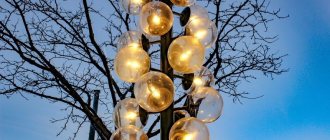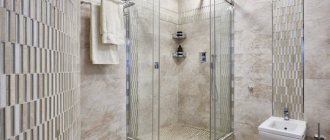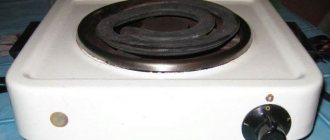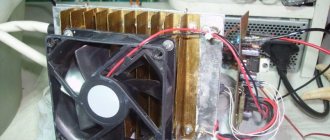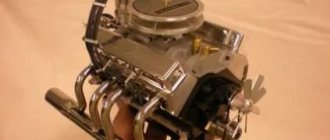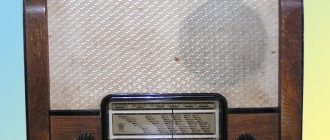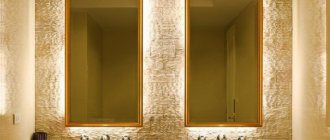Advantages of LED lamps
LED lighting elements are displacing conventional incandescent lamps from the market. This is due to a number of advantages of LED technology:
- The emission of light in semiconductors occurs more intensely. They are 8 times brighter than incandescent lamps, and also work better than sodium or energy-saving devices.
- Due to their high efficiency compared to common light bulbs, LEDs can save from 60 to 90% of electricity. LED devices consume less resources than energy-saving devices (by 15-20%).
- The maintenance cost of semiconductors is lower because they have few failures and failures. LEDs are used in difficult operating conditions - for emergency systems, on high-rise architectural objects, in structures with expensive installation, in bridge lighting.
- New devices are installed quickly, with considerable savings in cable costs, which in semiconductors require a smaller diameter.
- Service life of LED devices: more than 15 years when operating 8 hours a day.
- Low voltage is used to power LEDs. This makes their installation and operation safer than equipment designed for 220/380 V.
- Semiconductors have good resistance to vibration, increased mechanical strength, and high temperature characteristics.
- The color rendering index of semiconductor devices exceeds 80. Without wasting energy or using filters, the devices are able to provide deep and pure colors of light.
- LED devices are suitable for timers, volume sensors, dimmers (light intensity regulators). LEDs are widely used in programmable equipment with variable lighting intensity.
- There are no ultraviolet and infrared radiation in diode products, the light is monochromatic, there is no strobing or glare. This allows them to be used in lighting systems of various purposes, sizes and shapes.
- LEDs have a minimum start-up time. Even in frosty weather, the device instantly reaches the color temperature and the specified light level.
- Due to the absence of harmful radiation and heat, semiconductors can be safely used for medical purposes, as well as for lighting rooms with people, animals and plants.
- The devices are recycled after their intended service life without producing environmentally hazardous substances.
New Year's lantern
Not so long ago, all people celebrated the New Year. This is a bright, sincere, cheerful holiday. So, since the weather is still snowy outside, New Year's lanterns will still be relevant. After all, you can make the atmosphere in your apartment more festive and fabulous.
Among other things, there is an incredible amount of videos on the Internet on how to make a flashlight with your own hands, so such newfangled trends make this task much easier.
So, is everything you need to make a flashlight ready? Great. Follow the following action plan:
- Take a piece of paper in your hands and fold it in half.
- Make cuts where the sheet is folded. You should leave 1-2 cm of paper untouched.
- Unfold the leaf and fold it into a tube, gluing it at the edges.
- Cut and glue a handle to hang the lantern.
- Rejoice, because the New Year's decoration is ready!
LED rechargeable flashlight circuit
Simple circuits with conventional lamps are energy-consuming. They have a weak luminous flux and lead to rapid failure of the lamps. To get rid of these disadvantages, more complex devices are used with batteries instead of batteries and LEDs that replace incandescent lamps.
To improve the performance of the flashlight, additional elements are included in its circuit:
- Charging is carried out from a 220 V network through a rectifier using a smoothing capacitor C1. The circuit is designed to convert some of the electricity into heat and limit the voltage applied to the battery.
- To indicate the charging process, the VD1 LED is included in the circuit.
- LEDs are used as load in the flashlight.
Lantern made from clothespins
A very simple but interesting way to make a flashlight with your own hands. Quite an attractive craft in appearance.
To make it, you will need a medium-sized glass shot glass or a short glass, as well as wooden clothespins and glue. The entire surface of the container must be tightly covered with clothespins. Leave a little space between the clothespins.
Position the clothespins so that the clip is facing down. If desired, the clothespins can be painted in different colors.
But it is better not to use plastic analogues, they can melt and emit an unpleasant odor. Place a small candle inside the glass.
At this point the flashlight is ready, just light the candle and enjoy the pleasant dim lighting. This flashlight can be used as a decorative element.
Circuit with super-bright LED DFL-OSPW5111Р
To operate the LEDs in this circuit, 2 AA batteries are used. DFL-OSPW5111P has high light brightness (30 cd). The current required for operation is 80 mA. The device glows white.
A ready-made unit is often used as a voltage stabilizer - the ADP1110 (1111) microcircuit, which belongs to the family of switching regulators capable of operating from power supplies with voltages from 2 to 12 V. The device has stationary outputs 12 V, 5.5 V, 3.3 V .
It is possible to program different operating modes of the microcircuit:
- 200 mA at 5 V if using 12 V input and buck mode;
- 100 mA at 5 V from 3 V output and boost mode.
Power from any type of battery is supplied to a relatively large DC capacitor and from its plates to the ADP1110. For example, “tablets” can be used as an energy source.
To additionally filter the voltage and limit current ripple, the circuit uses an inductor and a Schottky diode. In the latter, due to the metal-conductor transition, a barrier effect occurs. The device is characterized by low forward resistance, increased speed and low junction capacitance.
Power sources and types of lamps
Of course, the flashlight must be connected to electricity, and a lamp must be selected for it. The most suitable lamps can be divided into the following categories:
- Classic incandescent lamps. They are used not only in the design of the exterior of summer cottages, but also indoors. However, it is not recommended to use them, since problems with monetary expenses may arise, because this is not the most economical option.
- Halogen light bulbs. In addition to the fact that this lighting method is more economical than the previous one, it will last much longer. However, there is a high sensitivity to voltage changes, as well as strong heating. This makes the use of such lamps impossible in plastic and similar structures.
- LED lamps are the most popular lighting option in summer cottages. They are extremely economical and do not contain any harmful substances. Therefore, this will be the best lighting method for your garden. The only drawback is their high cost, which not everyone will like.
Electricity must be used as a power source. If this is not possible, you can turn to solar panels, which can be installed anywhere. However, try to select a location where the greatest amount of solar energy is directed.
Lamps for the garden can not only improve the design of the exterior of your home, but also increase the level of illumination at night. And it is not at all necessary to purchase them in a store at expensive prices. You just need to put in a little effort and make such a product yourself. It all depends on your desire and imagination.
Required components for assembly
To assemble a flashlight with your own hands you will need:
- copper wires;
- batteries (“tablets”) or accumulator;
- LEDs;
- device for placing a power source;
- soldering iron and solder;
- knife;
- glue - liquid nails, epoxy resin, superglue (it is better to have a gun for precise application);
- switch;
- details of the voltage stabilizer depending on the circuit (you can use a microcharging module, for example, TP4056; or assemble a circuit from individual elements yourself);
- flashlight body;
- lenses for LED.
Features of decorative lanterns
Simple and aesthetic lanterns made of paper or cardboard do not provide much light. But their purpose is different: to make the atmosphere in the room more mysterious or romantic, even without a light source inside. This type of decor is very popular; both adults and children make lanterns with their own hands.
The tradition of decorating a home with paper lanterns originated in China. Since ancient times, the Chinese have used rice paper for crafts. It was distinguished by its transparency, lightness and low cost, and was easy to cut and paint.
Using paper scissors, you can realize any ideas, even decorate the exterior of a building according to the season. Lanterns look great on walls, ceilings, windowsills, and on Christmas trees. They are also often made for school or kindergarten craft competitions.
How to assemble it yourself?
Assembling an LED flashlight is not difficult if you have minimal skills in working with a soldering iron. For example, you can use an old personal computer motherboard and remove a “pocket” from it to hold the battery. This should be done carefully so as not to damage the surface and contacts.
The body of a small flashlight can be made from a syringe. To do this, use a paint knife to cut off the cone on which the needle is installed and remove the piston.
To avoid overheating of the LED, a radiator must be cut from an aluminum plate to the size of the lens. Using superglue, the lens holder housing is connected to the aluminum heatsink.
Solder the diode contacts with copper wire. As insulation, you can use a thermal casing and a lighter.
The part with the lens and LED should be secured with glue to the body of the syringe.
We connect the LED contacts to the battery contacts and insert them into the structure.
If the charging module board does not fit into the remaining part of the syringe, it can be divided into two parts and connected together with tape. Broken contacts should be soldered with copper wire.
The microswitch must be connected through a resistor to the charging module board. The remaining contacts of the module are connected in accordance with the diagram.
After assembling the flashlight, a micro-USB connector and a switch button should remain on the surface. If the work is done correctly, such a flashlight will work for 10-12 hours on a single charge.
Tools and materials
In order for lighting to fulfill its full role, you need a good plan. Before you make a street lamp with your own hands, you need to walk through the area and mark the installation locations of the lighting fixtures. After this, make a drawing detailing the locations of wires, mounting boxes, sockets and switches. The project will be the basis for calculations and subsequent purchases.
In order to make a garden lantern, you need to have the following tools and materials:
- roulette;
- shovel;
- level;
- Bulgarian;
- hammer;
- screwdriver;
- mounting knife;
- soldering iron;
- insulating tape;
- fasteners (screws, staples, nails, couplings).
Regardless of what type of lamps is chosen for arranging the garden, you need to connect a source of electricity to them. This can be a 220 V industrial network or a battery.
Wires can be pulled through the air or laid in the ground . When a decision is made in favor of the aerial option, you will need a strong cable stretched between poles, buildings and trees. Cables are attached to it; it is forbidden to pull them tightly; the connection must be floating with a small allowance.
To lay wiring in the ground, you must use plastic pipes. It is best to choose products made from reinforced polypropylene. Such pipes will reliably protect the cable from moisture and mechanical influences. The pipeline is assembled using a special soldering iron.
A battery-powered chandelier is hung in places where it is impossible or unprofitable to connect an industrial network. Power is provided by reusable batteries, disposable batteries or solar panels.
Finalization of the finished LED flashlight
In some cases, it is easier to buy an inexpensive ready-made LED flashlight and, with the help of small improvements, make a more advanced model.
For example, in the HG-528 HUAGE device and flashlights similar in circuit design, diodes EL1-EL5 often fail. The problem arises because owners often forget to disconnect semiconductor elements when charging from the mains.
You can modify your flashlight so that it will be impossible to charge unless you change the position of the SA1 switch so as to turn off the LEDs. In addition, the short-lived batteries of these devices can be replaced with more energy-intensive lithium-ion devices from mobile phones. Why are rectifier diodes VD1-VD4 and a filter consisting of capacitance C1 and two resistors R1, R2 removed from the flashlight?
After a small cutting of the plastic parts of the case, a cell phone battery is placed in the vacant space. The latter is connected with a copper wire to the device circuit.
The developers of the Lentel GL01 LED rechargeable flashlight made an error in the electrical circuit, which also leads to failure of the device if it is turned on for charging when the LEDs are not turned off. In addition, 7 diodes are connected in parallel, which causes uneven current flowing through them during operation of the flashlight due to the different current-voltage characteristics of the semiconductor elements. This leads to frequent burnout of both the LEDs themselves and resistor R4.
If individual resistors (45 - 55 Ohms) are connected in series with each LED, and resistor R4 is removed from the circuit, then the current values will be equalized. To prevent voltage from reaching the LEDs of the charger while charging the battery, you need to connect HL1 (indicator) to the first pin of SA1.
Paper lanterns
If you look at various diagrams and instructions on how to make a flashlight yourself, you will easily notice that making it from paper is easier than from any other material. Moreover, even a child can make a beautiful lantern from colored paper under the supervision of an adult.
You can see countless samples on the Internet and by looking at them you can complete them quite quickly. If you want to make a beautiful lantern, you can additionally decorate it with an accessory such as paper ribbon.
A paper lantern is a rather cute symbol, so even if some homemade lighting assistants do not shine at all, they are forgiven for their lack of functionality.
In addition, they are so beautiful that making them is very interesting not only for children, but also for adults. Today, simple and powerful hand-made flashlights are becoming an item that is even made with kids in kindergarten.
